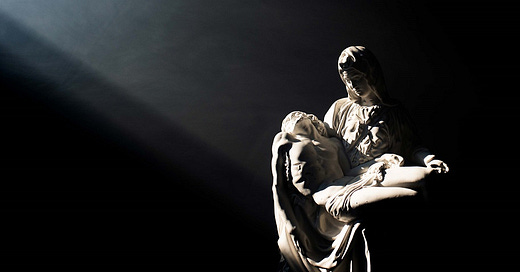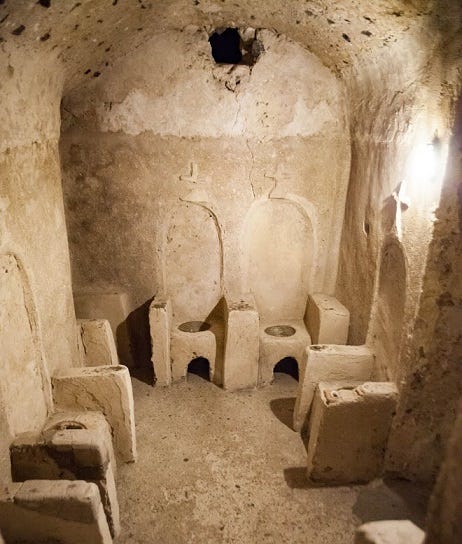A Meditation on Death
I’ve seen a dead body once in my life outside of a funereal context. It was in India, I was wandering around a small city in Maharashtra, can’t remember which, and I encountered a group of people on a bridge whose attention was drawn by something below in the river. Joining them, I peered over the edge, where the severely bloated corpse of a man lay half-submerged in the water. It wasn’t a particularly gruesome sight, and it was more surprising than shocking, given that I’d only ever seen a corpse in a coffin before. In Nepal, I visited the burning ghats at Pashupatinath, where the bodies of dead relatives are burned for the grieving families, and where I could wander freely as a tourist among the mourners. Small naked boys dredged the river barefoot where the remains of corpses were tossed into the water, looking for rings, necklaces or gold teeth. But what was more troubling for me than both these encounters was the occasion that I came across an old man lying naked on a train platform in some other forgotten part of India, seemingly close to death. He lay there, barely moving, while two employees of Indian Rail ate a packed lunch only metres away, ignoring him completely. Distressing as it was, either my feeling of revulsion or powerlessness meant that I did nothing to help him.
From all my encounters in India, I have to conclude that illness and the process of dying is much more troubling to me than death itself, a feeling which I imagine I am not alone in and one which is probably shared by many if not most of the human race. It is much more difficult to sit with someone who is terminally ill than to sit next to the body of a dead friend or relative. After all, there is no need to communicate with a dead body, at least not vocally. Sitting next to someone you know is going to die, what do you say? Do you weep, assault them with false optimism, read them scripture? Faced with the inevitability of someone’s dying, what is the appropriate response?
I found India to be a place with an altogether different outlook on death, one much less troubled and fraught with anxiety than in the Western world. The impulse to hide the dead, to put them out of sight and mind as something shameful or polluted didn’t seem to be present in the Hindu worldview. Hindus believe in samsara, the process of death and rebirth, in which the atman (soul) leaves its current body upon death and, after a short period of transition, re-enters the world in a new ‘sleeve’ to strive towards Brahma, or God, through the gift of human toil and suffering. In this respect, it’s not too far from Christian beliefs, wherein the soul of the believer leaves the body to return to the godhead (minus all the rebirth, of course).
On a recent trip to Ischia, a small island in the bay of Naples, I came across a quite a gruesome ‘burial’ ritual in the Aragonese castle that looms above the port on the northeast corner of the island. In the sixteenth and seventeenth centuries, the Order of Saint Clare (the Poor Clares) had a presence on the island based in the castle itself. The order had a small nunnery there and visitors can still visit their crypt today. In a ‘putridarium’ below their chapel lie two small rooms filled with a series of bizarre ‘thrones’ (pictured above). Above the chairs, Christian crosses are carved, and in the seats, large holes. Upon death, sisters of the order were placed naked into the chairs and, over a period of months, their bodies would decompose and their fluids would empty out of them into special vases beneath the chair. The dead nuns would rest there until there was nothing left but bones, which would then be collected and placed into an ossuary for burial. The ‘humours’, which had collected in the vases, were considered sacred and placed in the chapel. But what was most interesting about this whole process was that the nuns used the putridarium as a place of prayer. Amongst the decaying bodies of their sisters, the nuns would pray, using the time to meditate on death and the transitory nature of life, and on the nature of the body as a mere vehicle between this world and the next. Needless to say, exposed daily to rotting corpses, many of the nuns fell ill. But this practice of meditation on the natural processes of life and death runs contrary to the bearing of modern Christianity towards death and dying, where bodies are hidden away as quickly and as noiselessly as possible, ferried to the morgue or the undertaker’s where they are encased in a heavy box, and then to the place of funeral where perhaps the coffin is opened for a short time before burial. We don’t like to see death. We don’t like to be reminded of our mortality. Better to close it up, hide it away. This squeamish attitude towards death seemed to disappear in the Middle Ages. Similar practices to that of the Poor Clares can be seen in ‘bone churches’ across Europe, such as St. Bartholomew’s in Poland, San Bernardino alla Ossa in Milan, or the Sedlec Ossuary in the Czech Republic. Such monuments to death can only be considered as places of meditation on dying, a place where one cannot escape the stark reality of life’s greatest inevitability: ‘for dust you are and to dust you will return’.
The macabre fascination with which we view such places must be viewed in relation to the distance at which we are kept in our daily lives from death. I have to admire the Poor Clares for their willingness to break with the norms of Christianity to ‘stare Death in the face’, as it were, even if their complete lack of medical awareness meant that they were recklessly putting their health at risk. This lack of squeamishness doesn’t seem in keeping with the traditions of Christianity, but is more in line with some form of pagan death cult, and while no doubt stupid, their meditations have the mark of a certain psychological robustness, even bravery. As unfazed as I was at seeing the dead body in India, I’m not sure I could stomach watching a corpse decompose over a series of months.
As for my own death, I’d much rather be cremated than have my remains rotting in the soil. Not that it will matter much to me, either way. But as a writer, I like the poetry of having one’s ashes cast into the sea or across a place that has a particular significance for me. Then again, if they do stick me in the ground, I get to write something mildly clever on my headstone. Something, perhaps, like:
“He’s dead, but he’s okay with it.”
And I hope, if I’m graced with seventy years on this earth, that when the day comes, I will be.
Cover image by Grant Whitty @ Unsplash





